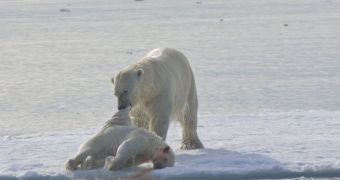It seems that genuine polar bears are far from being those cute creatures we spot in TV commercials resting on banks of ice. A recent study shows that these animals eat their cubs and climate change might be behind this rare case of cannibalism.
Photojournalist Jenny E. Ross has identified a disturbing incident of this kind, in 2010, when a giant polar bear turned a cub into its daily meal in the Svalbard archipelago of the Arctic, Huffington Post reveals.
She presented her photos and findings that were used as research material for a paper published in journal Arctic, revealing the contribution of polar bear specialist Dr. Ian Stirling.
Apparently, their stomachs needs rank first and once they are food-deprived cubs stand low chances of survival, since they are considered a mere source of proteins. Biologists note dramatic changes spotted in their habitat, like ice loss and increased temperatures feed their killer instincts, putting the young population at great risk.
All these transformations are linked to climate change phenomenon that triggers even more harmful consequences. For example, all the bears found in their natural homes are lighter and smaller.
Even though these animals wouldn't normally eat their own babies, incidents of such dramatic events have increased considerably in number in the Beaufort Sea, according to polar bear specialists. Most of them say they had never witnessed a similar situation in three decades of experience.
In the past, polar bears used to eat only the representatives of their own species that were obviously ill; as for their daily menu, it only included seals. Ross thinks their attitude change is favored by global warming lowering the number of seals and the amount of ice.
If the same conditions are preserved or even worsen, the polar bear population would suffer a significant decline.
"As the climate continues to warm in the Arctic and the sea ice melts earlier in the summer, the frequency of such intraspecific predation may increase,” concluded Ross.

 14 DAY TRIAL //
14 DAY TRIAL //